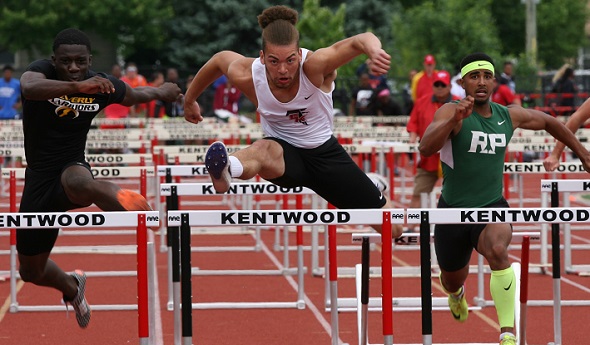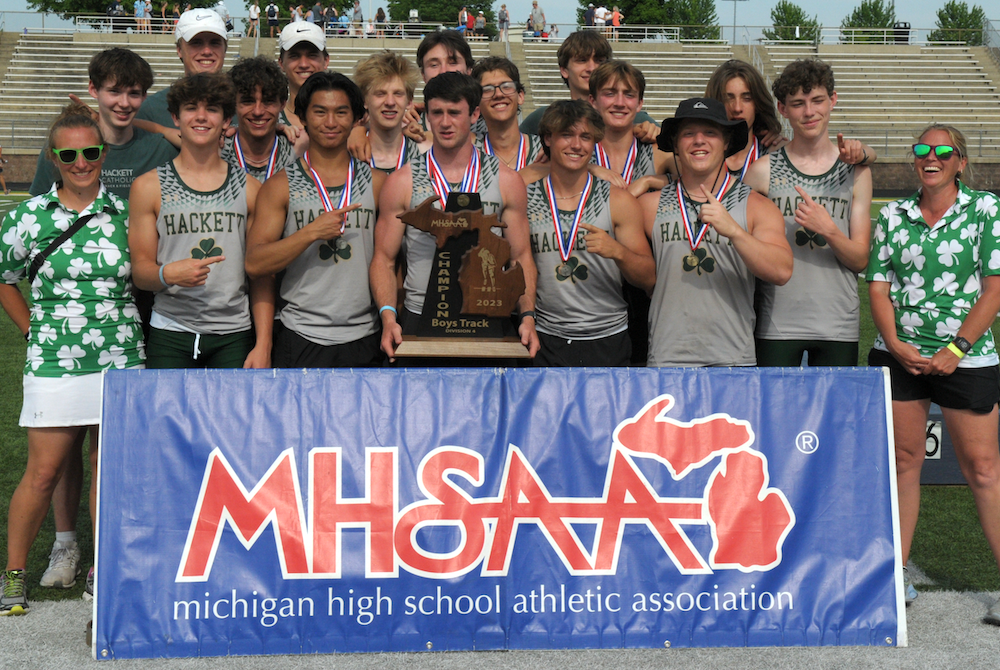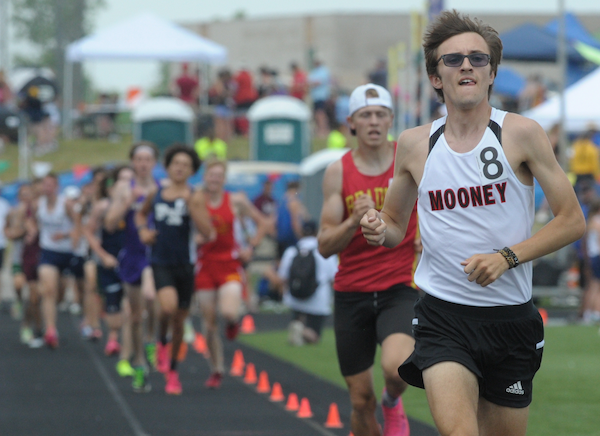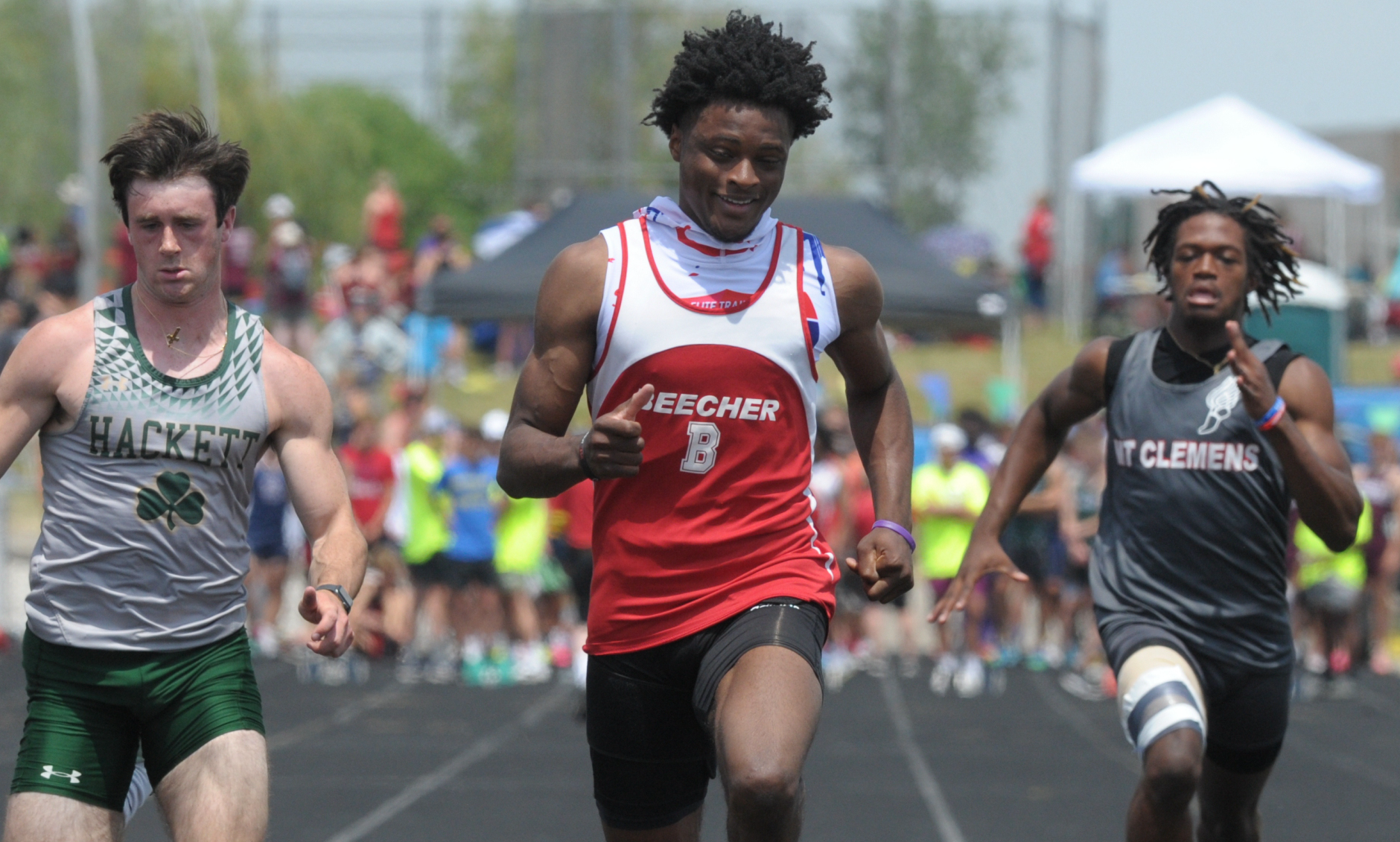
'Field & Track' Earns Falcons' Latest Title
By
Paul Costanzo
Special for MHSAA.com
June 2, 2018
EAST KENTWOOD – Dave Emeott is making some changes to his East Kentwood boys track & field team this summer.
After the Falcons’ field events put on a dominant display Saturday to lead the team to a second straight Lower Peninsula Division 1 championship, Emeott feels it’s time for a new name.
“Officially now, for at least one year, we’re going to be East Kentwood Field & Track from now on,” Emeott said. “Everything changes, the Twitter page, the Facebook page, T-shirts will be made. The field events guys took a lot of pride, and it was fun because those were the first events of the morning. We came out of the morning with 40 points, or whatever they ended up scoring.”
East Kentwood finished with 61 points, well ahead of second-place Ann Arbor Pioneer, which had 39. Saline and Grand Blanc tied for third with 37 points, while Rockford was fifth with 35.
Logan Brown (shot put), Trevor Stephenson (pole vault) and Job Mayhue (110-meter hurdles) won individual titles for the Falcons, who have won seven of the last 10 team championships in the division. By the time Mayhue won the hurdles, the third running final of the day, his team already had 46 points, which would prove enough to clinch the title.
“When you look at where we won, it wasn’t just that we were overwhelmingly more talented than everybody; where the points were scored was in the technical events – shot put, long jump, pole vault – those three events alone we scored with seven guys in those events,” Emeott said. “Then the hurdles and the relays, that was really our day. It’s cool to do it in a different way.”
Stephenson’s pole vault title came after a head-to-head battle with Saline’s Eric Harris that featured multiple MHSAA Finals records. Stephenson won with a height of 16 feet, 9½ inches, a new all-division meet record. Harris took second at 16-6½, which also broke the previous record.
“I was surprised that I cleared that,” Stephenson said. “I was coming in thinking 16 feet might be the winning height, then Eric Harris from Saline just kept pushing the bar up and I just kept going with him. Eventually it got to 16-9½, and I just didn’t feel like it was there, and I got over and it was an amazing feeling.”
Mayhue won the hurdles with a time of 13.99 seconds, while Brown won the shot put with a throw of 57-1½.
Rockford’s Cole Johnson pulled off an impressive double in the 800 and 1,600, winning both with strong finishes. In the 800, he ran past a tight pack in the final 50 meters to win in 1:53.11, edging out Ann Arbor Pioneer’s Netunji Paige who finished in 1:53.41.
In the 1,600, Johnson took an early lead, then had to surge over the final lap to overtake a strong field and win in 4:08.47, less than two tenths of a second ahead of Pioneer’s Nick Foster who was second in 4:08.64.
 “My race plan in the beginning (of the 1,600) was to try and push the pace to try and beat our school record held by Dathan Ritzenhein, a 4:05.9,” Johnson said. “The first lap, I knew I was going to go out fast, and I just tried to keep pushing it the second and third lap, but I fell off a little bit. Then the race plan was just kind of holding form a little bit that last lap to try and get the win. I found a lot of energy from all the people supporting me and all the fans; it is packed here today. Winning the mile in Michigan is very prestigious, so that’s kind of what kept me going as I got passed on that last lap.”
“My race plan in the beginning (of the 1,600) was to try and push the pace to try and beat our school record held by Dathan Ritzenhein, a 4:05.9,” Johnson said. “The first lap, I knew I was going to go out fast, and I just tried to keep pushing it the second and third lap, but I fell off a little bit. Then the race plan was just kind of holding form a little bit that last lap to try and get the win. I found a lot of energy from all the people supporting me and all the fans; it is packed here today. Winning the mile in Michigan is very prestigious, so that’s kind of what kept me going as I got passed on that last lap.”
Oak Park’s Donnie James pulled off a double of his own, and was four hundredths of a second away from pulling off a triple. James ran 47.14 to hold off a strong field in the 400 meters, and 21.2 to squeak out a win in the 200. He finished second in the 100 with a time of 10.7, just edged by Eric Labonte of Traverse City West, who won in 10.66 seconds.
In the 400, James won from an outside lane, holding off charges from Saginaw Heritage’s Marcus Montgomery (47.65) and Ypsilanti Lincoln’s Matthew Moorer (47.79), who were chasing him from the inside.
“I had that mentality that I know I had to run at full speed because I had Matthew Moorer and Montgomery (behind me),” James said. “It was a lot of competition during that time, so I had to get my head geeked because I knew I had to run this to get first place for our team. My coach said catch the dude off the turn and to just run it like you did indoors.”
Lansing Waverly’s Keshaun Harris won the 300 hurdles in 37.81 seconds. Pioneer’s Foster won the 3,200 in 9:07.93. Grand Blanc’s Aidan Martini won the discus with a throw of 167-2. Traverse City Central’s Cassidy Henshaw won the high jump with a height of 6-9. West Bloomfield’s AJ Abbott won the long jump with a distance of 23-7¼.
Ann Arbor Pioneer (Foster, Paige, Aldo Pando-Girard and John Florence) won the 3,200 relay in 7:45.64. Detroit Martin Luther King (Jaeveyon Morton, Dylan Brown, Dequan Finn and Jalen McGaughy) won the 800 relay in 1:26.74. Farmington Hills Harrison (Moet Andrews, Alfred Hollie, Joe Stevens and Ben Williams) won the 400 relay out of the second heat with a time of 42.39. Grand Blanc (Austin Rippee, Victor Zarour, Jo Coleman and Jeronn Body) won the 1,600 relay in 3:20.48.
PHOTOS: (Top) East Kentwood’s Job Mayhue, middle, hurdles to the lead on the way to winning the 110 race. (Middle) Oak Park’s Donnie James, right, holds off Ypsilanti Lincoln’s Matthew Moorer in the 200. (Click for more from RunMichigan.com.)

Thrower Claims Lone Individual Title to Lead Hackett to Team 3-Peat
By
Tom Lang
Special for MHSAA.com
June 3, 2023
Kalamazoo Hackett Catholic Prep just keeps winning and winning.
This time the Irish took home their fourth title in the last five Lower Peninsula Division 4 Track & Field Finals, on Saturday at Hudsonville.
Hackett’s only individual title was taken by discus winner Nathan Buchmann, a senior, who was fine knowing he was the shortest in stature among all the sizable competitors.
“In the offseason after football I worked out every day, working towards this goal,” he said after getting his medal. “I would say this takes 80 percent technique and 20 percent strength to throw the discus. So, length can help but if you have good technique and are really strong, that will play into it.
“I think we are very balanced throughout the meet today,” he said about teammates that scored points in finishes other than first place. “We have 13 guys here today, and we have people in a lot of the races. But I do not run; I have too short of legs to be a fast runner,” he said with a chuckle.
Buchmann had to work through a hip injury to compete this spring.
“I think the setbacks are what make you strong,” he said. “You can either give up through the setbacks or push forward and become better.”
 Coach Charissa Dean agreed.
Coach Charissa Dean agreed.
“The kids have big hearts,” she said after all the points were totaled and the Irish were on top once again, with 53. “They worked hard. They had a lot of potential when we started the season. And we had a lot of drive to put in the work, and we are happy the results came out the way they did.”
Reading was runner-up at 47 points, followed by Wyoming Potter’s House Christian with 42, then Fowler and Flint Beecher each with 37 points.
Senior Lezawe “Moses” Osterink, of Potter’s House Christian, placed second in 1,600 but took the 3,200 title as defending champ of both. He dominated the latter by lapping the field with a final lap kick that resembled more of a superhero speedster.
“Nobody really took it out that hard at the start,” he said. “There was a freshman (Marek Butkiewicz of Hackett) that tried to get the pace going quick, but me and Dakota (Dykhuis of Montabella) just kind of sat back and gradually pulled him through.
“We took it gradually, and I was just relying that I could kick.”
Kick did he ever. The trio were neck and neck the majority of the race in a grouping ahead of the pack.
“With 400 to go I just tried to go all out,” Osterink said. “I had a lot more left than I thought and I was pleased with the win. Not really the time, but that doesn’t matter, especially this hot out.”
The overall meet was in the low 90s/high 80s heat and searing sun all day. So, race officials allowed the unique opportunity for coaches to spray the runners with water and give them water bottles.
“It was very weird because I’ve never taken water to drink while I’m running, so I didn’t know how that would feel,” Osterink said. “And they were spraying us and hitting us in the face. It was kind of fun.”
Junior Tyler Lenn of Marine City Cardinal Mooney defeated Osterink at his own game in the 1,600.
“I’m feeling great,” Lenn said after grabbing the medal. “I said to a newspaper after one of my races (during the season) I was right where I wanted to be. This has been a long rebuilding process for me since an injury back in the fall, and I set a pretty high goal the day the injury happened. I was telling myself I needed to fulfill what I said I would do at the beginning of last cross country season. And that is what I did today.”
Lenn suffered an ankle sprain from a misstep that turned worse because he kept running through the season on it.
“Coming back from that was pretty tough, but I wouldn’t have it any other way,” he said.  “Perseverance; I said from the beginning what I was going to do. I kept my eye on that target, and no matter the circumstances life threw at me, that I was going to make it happen and I am a man of my word.”
“Perseverance; I said from the beginning what I was going to do. I kept my eye on that target, and no matter the circumstances life threw at me, that I was going to make it happen and I am a man of my word.”
Jaylin Townsend, a senior from Flint Beecher, dominated the short races. He won the 100 dash (10.67) and 200 dash at 22 seconds flat. It was his third 100 win at a Finals.
“I put in a lot of work; I had to three-peat,” he said after the 100. “There’s a lot of great competition here, so I knew I had to come out and run my best.”
Concord in the 400 (43.72), Buckley in the 800 (1:30.76) and 1,600 (3:29.13) and Potter’s House in the 3,200 (8:14.18) were relay champs Saturday. Reading’s Tayshawn Bester won the 110 hurdles (15.13), and Athens’ Landen Bennett won the 300 (39.85). Caseville’s Nathan Feltner won the 400 (50.76), and Vestaburg’s Owen Patton claimed the 800 (1:55.11).
Fruitport Calvary Christian’s Bradley Richards won the high jump (6-10), and Peck’s Alex Affer won the long jump (23-4). McBain Northern Michigan Christian’s Isaac Bowden was first in pole vault (13-0), and Brown City’s Kyle Affer won shot put (49-2).
PHOTOS (Top) Kalamazoo Hackett Catholic Prep celebrates its third-straight LPD4 title Saturday. (Middle) Cardinal Mooney's Tyler Lenn, far right, sets the pace in the 1,600. (Below) Flint Beecher's Jaylin Townsend, middle, crosses the finish first for one of his two sprint championships. (Photos by Ken Swart/RunMichigan.com.)

